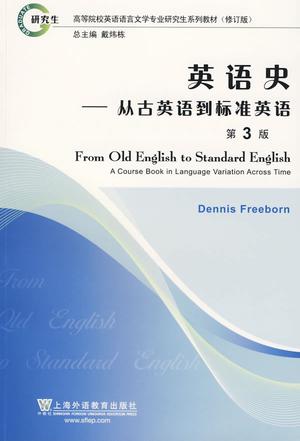目录
Preface to the third edition
Preface to the second edition
Symbols
Texts and facsimiles
Acknowledgements
1 INTRODUCTION
1.1 English today
1.2 Studying variety across time in language
1.3 How has the English language changed?
1.4 How can we learn about Old English and later changes in the language?
1.5 Changes of meaning - the semantic level
2 THE ENGLISH LANGUAGE IS BROUGHT TO BRITAIN
2.1 Roman Britain
2.2 Tbe Anglo-Saxon Chronicle
2.3 How the English language came to Britain
3 OLD ENGLISH (I)
3.1 Written Old English
3.2 The development of writing hands (i)
3.3 Dialects and political boundaries
3.4 Danish and Norwegian Vikings
3.5 Effects of Viking settlement on the English language
3.6 The Norman Conquest
4 OLD ENGLISH (11)
4.1 The language of Old English poetry
4.2 OE prose
4.3 OE grammar
4.4 Latin loan-words in OE
4.5 ON loan-words in OE
4.6 Early French loan-words
5 FROM OLD ENGLISH TO MIDDLE ENGLISH
5.1 The evidence for linguistic change
5.2 The Norman Conquest and the English language
5.3 The earliest 12th-century Middle English text
5.4 The book called Ormulum
5.5 12th-century loan-words
6 EARLY MIDDLE ENGLISH - 12TH CENTURY
6.1 Evidence of language change from late OE to early ME in La3amons Brut
6.2 The Owl & the Nightingale
7 EARLY MIDDLE ENGLISH - 13TH CENTURY
7.1 The Fox and the Wolf
7.2 The South English Legendary
7.3 A guide for anchoresses
7.4 The development of writing hands (ii) - from the llth to the 13th centuries
7.5 Three medieval lyrics
7.6 The Bestiary
7.7 The Lay of Havelok tbe Dane
7.8 Early 13th-century loan-words, 1200——49
8 NORTHERN AND SOUTHERN TEXTS COMPARED
8.1 Cursor Mundi - a history of the world
8.2 Later 13th-century loan-words, 1250-99 (see the Word Book)
9 THE 14TH CENTURY- SOUTHERN AND KENTISH DIALECTS
9.1 The dialect areas of Middle English
9.2 How to describe dialect differences
9.3 A South-Eastern, or Kentish dialect
9.4 An early South-West dialect
9.5 A later 14th-century South-West dialect
9.6 14th-century loan-words (see the Word Book)
10 THE 14TH CENTURY- NORTHERN DIALECTS
10.1 A 14th-century Scots dialect
10.2 Another Northern dialect - York
10.3 The York Plays
10.4 Northern and Midlands dialects compared
10.5 Chaucer and the Northern dialect
10.6 Loan-words, 1320-39 (see the Word Book)
11 THE 14TH CENTURY- WEST MIDLANDS DIALECTS
11.1 A North-West Midlands dialect- Sir Gawayn and ]~e Grene Kny3t
11.2 A South-West Midlands dialect - Piers Plowman
11.3 Loan-words, 1340-59 (see the Word Book)
12 THE 14TH CENTURY - EAST MIDLANDS AND LONDON
DIALECTS
12.1 The origins of present-day Standard English
12.2 The development of writing hands (iii) - the 14th century
12.3 A South-East Midlands dialect - Mandevilles Travels
12.4 The London dialect - Thomas Usk
12.5 Loan-words, 1360-79 (see the Word Book)
13 THE LONDON DIALECT - CHAUCER, LATE 14TH CENTURY
13.1 Chaucers prose writing
13.2 Chaucers verse
13.3 Editing a text
13.4 Loan-words, 1380-99 (see the Word Book)
14 EARLY MODERN ENGLISH I - THE 15TH CENTURY
14.1 The beginnings of a standard language
14.2 The development of writing hands (iv) - the 15th century
14.3 Chancery English
14.4 Early 15th-century East Midland dialect - The Boke of Margery Kempe
14.5 Later 15th-century East Midland dialect - the Paston letters
14.6 Late 15th-century London English - William Caxton
14.7 The medieval tales of King Arthur
14.8 Late 15th-century London dialect - the Cely letters
14.9 15tb-century loan-words (see the Word Book)
15 EARLY MODERN ENGLISH II - THE 16TH CENTURY (I)
15.1 The development of writing hands (v) - the 16th century
15.2 The Lisle Letters
15.3 Formal prose in the 1530s
15.4 A different view on new words
15.5 John Harts An Ortbographie
15.6 The Great Vowel Shift
15.7 Punctuation in 16th-century texts
15.7 Loan-words, 1500-49 (see the Word Book)
16 EARLY MODERN ENGLISH Ill - THE 16TH CENTURY (11)
16.1 The development of the standard language
16.2 Evidence for some 16th-century varieties of English
16.3 English at the end of the 16th century
16.4 Loan-words, 1550-99 (see the Word Book)
17 EARLY MODERN ENGLISH IV - THE 17TH CENTURY (I)
17.1 Evidence for changes in pronunciation
17.2 Sir Thomas Browne
17.3 The development of writing hands (vi) - the 17th century
17.4 George Foxs Journal
17.5 John Milton
17.6 John Evelyns Diary
17.7 The Royal Society and prose style
17.8 Loan-words, 1600——49 (see the Word Book)
18 EARLY MODERN ENGLISH V- THE 17TH CENTURY (11)
18.1 John Bunyan
18.2 Spelling and pronunciation at the end of the 17th century
18.3 John Dryden
18.4 North Riding Yorkshire dialect in the 1680s
18.5 Loan-words, 1650——99 (see the Word Book)
19 MODERN ENGLISH - THE 18TH CENTURY
19.1 Correcting, improving and ascertaining the language
19.2 Dr Johnsons Dictionary of the English Language
19.3 The perfection of the language
19.4 The Genius of the Language
19.5 Bishop Lowths Grammar
19.6 The depraved language of the common people
19.7 Propriety & perspicuity of language
19.8 Language and social class
19.9 William Cobbett and the politics of language
19.10 18th-century loan-words (see the Word Book)
20 FROM OLD ENGLISH TO MODERN ENGLISH - COMPARING
HISTORICAL TEXTS
20.1 Commentary on Text 173
20.2 Your accent gives you away!
21 POSTSCRIPT - TO THE PRESENT DAY
21.1 Some developments in the standard language since the 18th century
21.2 The continuity of prescriptive judgements on language use
21.3 The grammar of spoken English today
21.4 19th-&20th-century loan-words (see the Word Book)
Bibliography
Index
【展开】
【收起】
内容简介
《英语史:从古英语到标准英语(第3版)》是一部以历史文献为核心的英语史教程。它通过大量原汁原昧的选文,从语音词汇、语法、书写法和社会背景等方面全方位地展现了英语的演变过程。选文来自各时期的经典文献,大多附有原文扫描圉片、转写文本(包括用古英语字体和当代英语书写体转写的文本)以及现代英语译文(包括逐词翻译及意译)。《英语史:从古英语到标准英语(第3版)》还配有专门的网站,提供选文的词汇表、文本详解和文本朗读,丰富了书本内容,而且具有很高的资料价值。
【展开】
【收起】
下载说明
1、追日是作者栎年创作的原创作品,下载链接均为网友上传的的网盘链接!
2、相识电子书提供优质免费的txt、pdf等下载链接,所有电子书均为完整版!
下载链接
